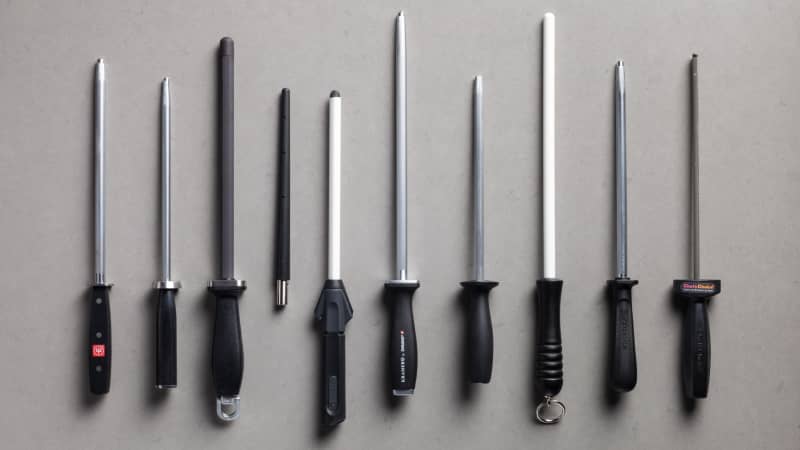Manual Knife Sharpeners
Equipment Review
It's supposed to keep your knife sharp, but does it work?
Published July 18, 2019. Appears in America's Test Kitchen TV Season 21: A Trip to Vietnam

We've all sat at holiday tables watching our host put on a show before carving the roast, slashing a knife in the air, back and forth, against a honing rod—swish, swish, swish. It sure looks impressive, but I've always secretly wondered: Does that really sharpen a knife?
To find out, I bought nine honing rods. All had the same basic design, a sticklike rod with a handle on one end. The rods themselves ranged from 8 to 12 inches long and were made of steel, ceramic, or diamond-coated steel. Their surfaces varied, ranging from smooth to ridged to a combination of textures. The most unusual model was a handle with two interchangeable rods—one diamond-coated steel, the other ceramic. To test them, I bought nine copies of our favorite chef's knife, a sheaf of copy paper, dozens of tomatoes, and a glass cutting board (the fastest way to dull any knife) and headed to the kitchen.
To this honing novice, everything about this tool was confusing, starting with the terminology. When I researched “honing rods,” “honing steels,” “sharpening steels,” and “sharpening rods,” I found that there was no industry consistency, with some sources insisting that these were different tools and others using the terms interchangeably. Did these tools all perform the same function? I included some of every type to find out.
Since I'd never used a honing rod, I read the instructions (though some arrived without any) and practiced. The test kitchen's preferred technique is to plant the tip of the rod on a cutting board, hold it straight, and slide the knife from heel to tip down each side of the rod at about a 15-degree angle, maintaining light, consistent pressure. While you could hone in the air, like my holiday host, we find this less reliable because you have two moving pieces, which makes it harder to keep a consistent angle. Happily, I discovered that honing is not that scary or difficult. You get a feel for it after several minutes' practice.
I dulled the cutting edges of nine new chef's knives on that hard glass cutting board by chopping until the blade failed to cut smoothly through paper. This accelerated the typical effects of much longer use on more forgiving wood or plastic boards. I assigned one knife to each rod and started to hone.
Before honing and again after every few swipes, I tried to slice paper to help me gauge whether the blades' sharpness had improved. Then, since nobody slices up paper for dinner, I used the newly honed knives to slice tomatoes, knowing that sharp knives would glide through tough tomato skin, while dull ones would squash it, making oozing slices. Next, I asked five testers with varying...

The mission of America’s Test Kitchen Reviews is to find the best equipment and ingredients for the home cook through rigorous, hands-on testing. We stand behind our winners so much that we even put our seal of approval on them.

Lisa is an executive editor for ATK Reviews, cohost of Gear Heads on YouTube, and gadget expert on TV's America's Test Kitchen.

This is a members' feature.